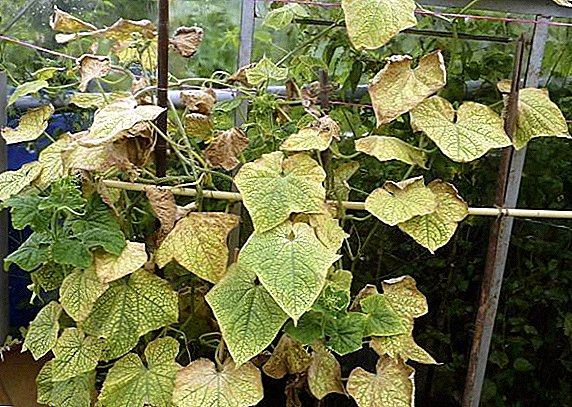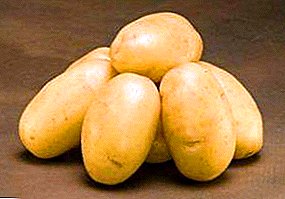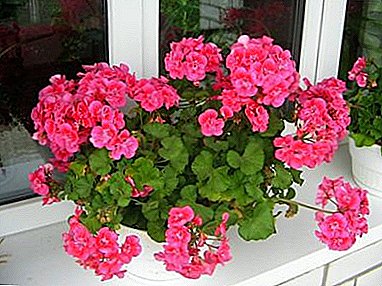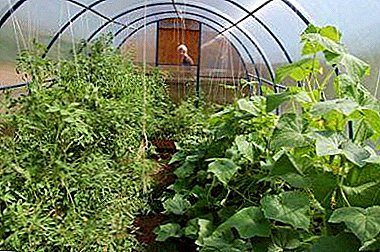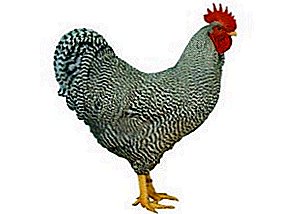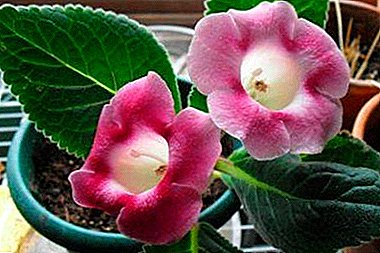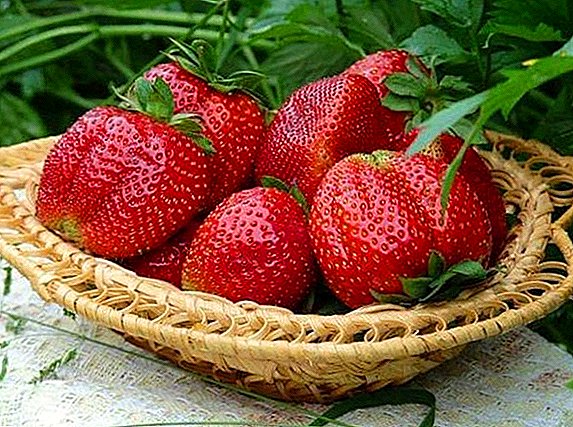 Every year, hundreds of new species and hybrids of cultivated plants are created in the world that are distinguished by disease resistance as well as productivity. In this article we will discuss an interesting type of strawberry "Zephyr", which is grown not only in greenhouses, but also on open ground. We learn what is interesting variety and whether to plant it on the plot. Consider the cultivation of agricultural technology.
Every year, hundreds of new species and hybrids of cultivated plants are created in the world that are distinguished by disease resistance as well as productivity. In this article we will discuss an interesting type of strawberry "Zephyr", which is grown not only in greenhouses, but also on open ground. We learn what is interesting variety and whether to plant it on the plot. Consider the cultivation of agricultural technology.
Description and characteristics of the variety
"Zephyr" - a variety of Danish breeding, used for both private cultivation and for commercial purposes. This tells us that plants produce a stable, large crop with good taste and commercial qualities.
Check out the variety of strawberry varieties: Tsarina, Chamora Trusi, Fresco, Zeng Zengana, Kimberley, Malvina, Asia, Marshal, Lord, Masha, Russian size "," Elizabeth 2 "," Korolea Elizaveta "," Gigantella "and" Albion ".We have a very early grade that forms small compact bushes. Leaves pubescent, kept on long, erect stems. Leaf color is standard.

As for the berries, they are of medium size, painted in a rich red glossy color. Berries are formed in the form of a cone.
Important! There are no voids inside the strawberry.The yield from one bush - up to 1 kg inclusive.
Benefits:
- berries have excellent taste;
- average fruit weight is 40-50 g;
- good yield;
- products do not lose their presentation during transportation;
- has resistance to many diseases (rot, powdery mildew, fusarium);
- berries ripen at the same time on all bushes;
- bush withstands temperatures down to -16 ° C.

We should also talk about frost resistance and the process of fruit ripening.
Strawberries - a real storehouse of vitamins for our health. Read the useful strawberries.Strawberries can withstand extreme cold to -35 ° C, but only if the ground is covered with a thick layer of snow. In the absence of snow, the socket can withstand temperatures down to -10 ° C, and the roots die if the ground freezes to -8 ° C. Therefore, it is desirable to cover beds for the winter with mulch.
In the process of ripening, the bush forms long upright strong stems on which berries ripen. Stems withstand their weight, so even before picking ripe strawberries, it will not touch the ground. This is very important, as you can not lay a mulch layer or agrofiber to protect and preserve ripe strawberries. 
Breeding
After you have planted several bushes on your plot and got a good harvest, the question arises how to multiply the Zephyr strawberries to get high-quality young plants.
Reproduction, as is the case with other varieties of strawberries, is carried out in three ways: seeds, mustache, dividing the bush.
To propagate strawberries with seeds is impractical. You will lose an enormous amount of time and as a result you will get very weak shoots, and young plants may not adopt the varietal qualities. As a result, you will waste a lot of resources.  Strawberry reproduction by seeds
Strawberry reproduction by seeds
As for the whiskers, this is the most optimal and fastest breeding option. A feature of this variety is the production of a large number of antennae, because of which one shrub can produce several daughter plants at once. It is best to wait for the full-fledged rooting of the shoots, and then to carry out the separation and transplantation.  Breeding strawberry mustache The division of the bush is a controversial breeding variant. The fact is that in this way reparantant strawberries are propagated. Repairman varieties are distinguished by the fact that they produce very few whiskers, but they bear fruit several times a season. In our case, the variety is not remontant and produces a huge amount of mustache, so you should not replicate the bush either, otherwise you will damage the mother plant, and the children will take root longer than those that are rooted from the mustache.
Breeding strawberry mustache The division of the bush is a controversial breeding variant. The fact is that in this way reparantant strawberries are propagated. Repairman varieties are distinguished by the fact that they produce very few whiskers, but they bear fruit several times a season. In our case, the variety is not remontant and produces a huge amount of mustache, so you should not replicate the bush either, otherwise you will damage the mother plant, and the children will take root longer than those that are rooted from the mustache.
Important! Each bush is able to release up to 20 whiskers, which is simply an incredible amount.Please note that the same 10-15 whiskers will give you not the same number of daughter plants, but much more. On each "branch" up to 8 outlets are formed, so only 1 bush can provide you with enough planting material, in order not only to plant a plot, but also to put a part on sale.
 Strawberry propagation by dividing the bush
Strawberry propagation by dividing the bushStrawberry Breeding Recommendations from the Internet
Usa


Agrotechnology
Consider the process of planting strawberries. You can also use this instruction for transplanting daughter plants.
Site selection and preparation
Sometimes it depends on the substrate more than on care, so you need to choose a good place and good soil for strawberries.
Planted plant should be on an open, flat terrain, so that trees or shrubs do not obscure planting. If the plot is not even, then one part of the strawberries will suffer from an excess of moisture, and the second - from the lack. 
With regard to the acidity of the soil, the best option is a neutral pH. If the soil is too acidic, then add lime, if it is too alkaline, sulfur or ammonium sulfate. Do not rely on the fact that the plant adapts to your conditions, otherwise you will get a meager harvest.
Now you need to decide on the nutritional value of the soil and drainage properties. Immediately you should abandon the site where heavy clay soils are located, or if the lion's share is sand. We need a light nutritious crumbly soil, which will pass air and moisture well.
As a fertilizer acts humus or peat. It is best to take care of the fertilizer area for the year before planting, since humus under the influence of the external environment should break up into more accessible elements for the plant. 
On 1 square make about 5 kg of humus or peat, so that the substrate is sufficiently nutritious and crumbly.
As for mineral fertilizers, it is better to abandon them first. In case of their shortage, the plant will give a clear signal, after which you can correct the situation. Remember that mineral fertilizers initially have an available form, so the strawberries do not need to wait a few trimesters to get the necessary macronutrients.
How and when to land
Planting strawberries should be carried out in late summer, in the second half of August. If you are not sure that the weather will be warm, then plant the plants before. 
Strawberries are planted in August for the reason that it needs a lot of time for rooting and acclimatization. If you plant it later, then the plant simply does not have enough reserves to survive the winter, and in the spring you either do not get a harvest at all, or there will be so little production that you doubt the characteristics of the variety.
Important! It is best to plant strawberries in the evening or in cloudy weather, so that the plants in the process of planting do not lose a lot of moisture.For each bush we dig a separate hole, the diameter of which must be greater than the diameter of the straightened root system. The depth of the hole is about 25 cm, should not be deeply buried.
 Planting strawberries
Planting strawberriesBefore planting a small amount of water is poured onto the bottom of the well, then the rhizome is carefully placed in the hole and straightened. Straighten the roots should be for the best and fastest rooting. So you save the power of the plant.
Strawberries are best planted next to tomatoes, parsley, garlic, onions, beans, cucumbers, raspberries, sea buckthorn, mint, clematis, grapes and marigolds, as these plants have a beneficial effect on it.After planting, the hole is filled with earth and very little tamped. Plentifully watered to moisture reached the roots.
 Fill the hole with earth
Fill the hole with earthIf the weather is hot, then after planting it is advisable to cover the bushes with grass or fallen leaves to protect the freshly planted strawberries from the sun.
Row Formation and Mulching
Strawberry bushes need enough space to form an above-ground piece. In addition, for each plant must be allocated its own area of land from which strawberries will draw nutrients and water. That is why be sure to take care of the correct formation of rows and spacing.
Between the rows, it is necessary to retreat about 60 cm, and between the bushes in the row it is enough 30-45 cm. Such a large indentation between the rows is done so that it is convenient to carry out watering and loosening. Also, do not forget that each bush lets a considerable number of whiskers, which are beginning to take root. If the indent is small, then the plot will turn into "impenetrable" strawberry thickets, as a result of which you will be left without a crop.  We plant strawberries in rows
We plant strawberries in rows
At the beginning of the article we wrote that this variety has good strong stems, so the berries do not require protection from contact with the ground. In this case, the benefits of mulch is not only to protect against rotting, so it is worth more to discuss this point.
Since the bushes are planted in good fertilized land in an open area, they will immediately begin to suffer from weeds, which will not only prevent you from weeding and harvesting, but will also begin to pick up the nutrients for strawberries from the ground.
If we are talking about large plantings, then lay the mulch is quite expensive and easier to handle planting chemicals, but in a small area mulch is an excellent protection against weeds. 
Straw or mowed grass is suitable as mulch. If you want to “bed” something more durable, then get an agrofibre that will serve more than one year.
Also do not forget that the mulch saves plants from temperature changes, excessive evaporation of moisture and cold. For this reason, it can be used even when the berries are not threatened by contact with the substrate.
Important! Coniferous branches can be used as mulch, as they scare away most pests.

Care
This variety can not do without pollination by insects. For this reason, in the conditions of the greenhouse it is necessary to create all the conditions so that the insects penetrate into the structure and do their work. If this does not happen, then you will have to manually do the pollination using a brush.
Watering
First of all, we analyze the composition and drainage properties of the soil, as well as the weather conditions in your region, since it is precisely this that determines the amount of irrigation and the amount of water applied.
If the soils initially have a large proportion of clay, then before each irrigation, check the soil moisture with a peg or a small stick. This variety can withstand drought, but will begin to rot from waterlogging, therefore, it is better to refuse watering once more than to overfill and lose the plant. 
Weather conditions also matter. If the increase in the need for moisture coincides with the rainy period, then it is not necessary to increase the amount of moisture introduced. The variety needs additional moisture only at the moment of active growth and the formation of berries. When the berries begin to ripen, excessive watering can only harm.
Pruning
The plant spends a lot of energy and nutrients on the formation of green mass. At the same time, excessive growth of greens negatively affects the yield. To obtain the expected amount of production, should be regularly pruned.
Left without care and pruning strawberry bushes quickly and densely overgrown. Find out how to properly and when to trim the leaves and mustache strawberries.If you are going to reproduce, then a large number of whiskers that this variety throws out will not hurt, but if you do not want to expand the area of planting, then you need to constantly cut off the whiskers so that they do not take nutrients from the plant.

During the rapid growth and pouring berries constantly cut diseased and dry leaves. Also do not forget about the formation of the crown. We need to get berries, not a big strawberry bush.
After harvesting (after 15-20 days), all old leaves should be cut, leaving only young rosettes. This will help the plant to prepare for wintering.
Soil care
If you have not laid mulch, then you will have to regularly engage in weeding and loosening to get rid of weeds and prevent oxygen starvation of rhizomes. Loosening is carried out exclusively in the evening or in cloudy weather, when there is no wind.
Weeding should be carried out quite often, since weeds not only take nutrients and moisture, but also carry diseases, as well as a temporary haven for pests. If weeding does not give results, then it makes sense to use chemical means.
Important! Apply chemicals only until flowering. After that, the use of herbicides is prohibited.

Top dressing
Top dressing can be divided into two stages: after harvest and before wintering.
Once all the berries have been harvested, the bush should be fed to the slurry diluted in water or chicken droppings.
This is done as follows: we take in equal proportions animal waste and water, and then soak it in an open container for 10 days. Next, the resulting fermented mixture should be diluted with water 1 to 10 before watering strawberries.  Top dressing of strawberry slurry
Top dressing of strawberry slurry
On 1 square consumes about 7 liters of feeding.
Important! After feeding, it is necessary to conduct sprinkling.The second time fertilizers are applied in the autumn. Purchased mineral supplements are used for this. 40 grams of nitrophoska and 30 grams of potassium sulfate are diluted with 10 liters of water. Consumption per bush is 1 liter of the mixture.
Autumn dressing should be made before it gets very cold outside, as the plant must receive all the nutrients long before the frost, otherwise the strawberry will overwinter badly.  Nitrofoska
Nitrofoska
Wintering
Regardless of whether there is a lot of snow in your region or little, before the expected frosts, bare strawberry need to be tucked up so that they are completely covered with soil, otherwise the plant will die very quickly.
Consider all the details of the proper fit and care for strawberries.If there is enough snow in the winter, then there is no need to cover the additional beds, but if the winters are not snowy, then additional shelter will not interfere. As it can be used branches or lapnik. If such materials are not at hand, then you have to purchase a special version of the spunbond, which will serve as a good insulation. The thickness of the material depends on what frosts the nonwoven material can protect your strawberries.
 Shelter strawberries spruce branches for the winter
Shelter strawberries spruce branches for the winterPreparing for winter on open and closed ground is different, so do not cover the strawberries in the greenhouse with spruce branches or spunbond. Similar, more likely, harm than help.
Did you know? Strawberry helps to cope with headaches. This is due to the fact that the composition of the berries include substances similar to those contained in aspirin.
Fight against diseases and pests
Strawberry "Zephyr" has resistance to some diseases. However, in adverse conditions, the bushes will still hurt, so do not forget about prevention.
In the spring, bushes are treated with the following chemicals: Karbofos or Karate. This is done in order to prevent the emergence or destruction of such pests as nematodes, weevils, transparent mites, slugs. 
Such preventive treatment is carried out in the autumn, after harvest. During this period, chemical treatment can be replaced by spraying with vinegar and a solution of ash.
- White and brown leaf spot. These are similar fungal diseases that appear as small spots that appear on all parts of the plant. The spots increase in diameter over time, due to which the heavily affected parts of the plant die off. To combat the fungus, systemic fungicides are used. Processing is carried out before flowering and after harvesting. It also does not hurt to carry out a third treatment in October to kill the fungal spores that hibernate.

- Strawberry tick. This is a tiny parasite whose length rarely exceeds 0.2 mm. Such small size makes it "invisible" to the human eye.For this reason, the presence of a tick can only be identified by the symptoms of the plant. The affected bushes become smaller, the yield drops several times, and such plants often do not survive the winter.
In order to get rid of tick or to prevent its occurrence, it is necessary to treat the area of colloidal sulfur (100 g per 10 liters of water). Spend about 3 treatments at intervals of half a month. Handle best in spring, before flowering. If you doubt the effectiveness, then repeat the treatment after harvest. Colloidal sulfur can be replaced with "Actellic" or "Actofit" preparations.
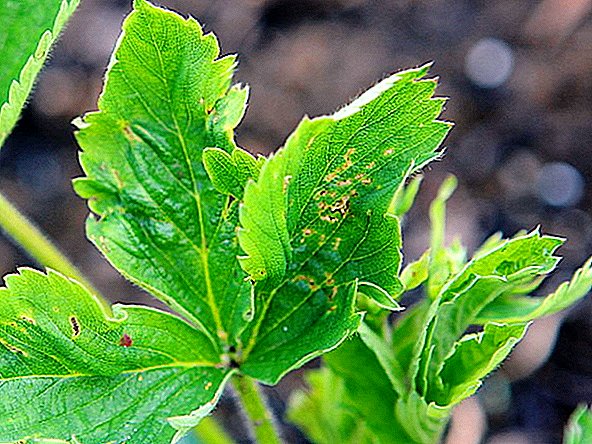
- Nematodes and weevils, flowering beetles. Infected plants are simply not treated. In the case of a nematode, there is no treatment, and it makes no sense to spray strawberries from the weevil, since it lays eggs in flowering buds. If we process the plant during flowering, then we get a poisonous berry. In the end, it turns out that prevention is a mandatory step.

Did you know? Scientists have found that the amount of nutrients depends on the saturation of the color of the berry, so you should give preference to dark red strawberries. It is not entirely clear how to identify the saturation of white pineapple strawberries, which is gaining popularity.That's what a strawberry "Zephyr" is, its differences from other varieties, the rules of planting and caring for bushes. Remember that strawberries require regular renewal (once every 4 years), as every year more and more root buds form on the bush, and the rhizome itself does not increase in volume. This leads to rapid aging and reduced productivity. Follow the outlined rules of care, and you can avoid strawberries from pests and diseases.
Recommendations network users about growing strawberries
Strawberry grows well on a flat surface, on a surface with a slope facing the south-west. It is impossible to grow strawberries on steep slopes, also on low-lying places where cold air accumulates, which makes the harvest late, and the number of diseases increases. Unsatisfactory results are also obtained on a steep southern slope, where the snow quickly melts and as a result the strawberries become bare. Strawberry is moisture-loving, but does not tolerate overwetting. The place where strawberries grow should be protected from the winds, since part of the root system freezes out at a temperature of 10-12 ° C cold, so it is better to overwinter under the cover of snow with a layer of at least 20-25 cm. Strawberries cannot be grown for more than 4 years (good for 2-3 years), as it accumulates various infections and fungal diseases, such as wilt, gray and white rot and other diseases.
Reproduction
Strawberries are propagated by seedlings (rosettes). Seedlings either buy or grow on their own planting, which is grown on shoots (whiskers) uterine bushes. The best sockets are those that are closer to the uterine scapula. No more than three sockets are left on the shoot, up to 5 sockets can be left, but in this case the last two will be less developed than the first three. On one uterine bush with three sockets. With one bush get 15 pieces of well-developed outlets.







